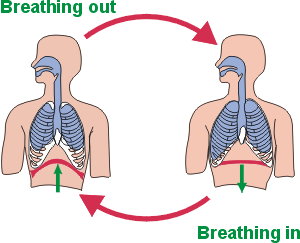 Chest breathing and belly breathing are the two most common types of respiration.
Chest breathing and belly breathing are the two most common types of respiration.
Like many actions of the body breathing is simple yet complicated. Almost everyone takes it for granted and most think that because it happens unconsciously you don’t need to learn how to do it correctly.
The same thing goes for walking and needless to say I think everyone needs to relearn how to walk.
Chest breathing is the default method for almost everyone I work with and teach. This is due to poor posture and societal norms.
Chest up and shoulders back are the standard instructions most of us receive when being implored to stand up straight by desperate parents who fear slumping children.
Classic military posture employs these two instructions as well and as a result, these images are deeply ingrained in our culture.
When I ask an individual or a group of people to stand up straight this is almost always what I see—the front of the rib cage elevates and the arms move backward.
The diaphragm muscle is the main apparatus of breathing. When we inhale the diaphragm muscle ideally has the space to descend a little which will create a vacuum pulling air into the lungs.
When we exhale the diaphragm should ascend as the lungs return to their original state.
This type of breath sees the belly distend a little as the abdominal contents push forward to accommodate a dropping diaphragm.
This will only happen if the spine is correctly aligned and the diaphragm muscle is free to drop. Chest breathing is the result of a diaphragm muscle that lacks the ability to sink down.
In a diaphragmatic breath, the chest is involved because ideally breathing uses the entire trunk expanding up, down, front, back, and side to side, but the initiation of the breath should begin with the belly moving out rather than the chest lifting.
In chest breathing, there is less ability for the whole trunk to get in the game.
As a result of chest breathing the muscles of the chest and neck, which are ideally the secondary muscles of breathing, become the primary muscles of breathing getting consistently overworked.
The average person takes somewhere between 18-20,000 breaths a day, so that is a considerable amount of excess effort.
Chest breathing also tends to be faster, more shallow, and much less efficient. Breathing is essentially a process of gaseous exchange drawing in oxygen (and other gases)and releasing carbon dioxide (and other gases).
Chest breathing reduces the amount of oxygen we take in which can have grave consequences possibly increasing stress, anxiety, and tension, as well as negatively impacting your blood pressure.
Excessive chest breathing can lead to living in a constant, though mild, state of hyperventilation which is the rapid breathing that happens with anxiety or panic.
Rapid breathing creates low levels of carbon dioxide in your blood which causes many of the symptoms of hyperventilation.
There are numerous reasons for why so many people rely on chest breathing but like I said at the top many people are rely on chest breathing because of misguided ideas about good posture.
When someone stands before me in their image of good posture and employs chest breathing I ask them to find a position where they can breathe diaphragmatically into the belly. Very often they report feeling slumped over or rounded forward when breathing this way.
My response it to tell them to stand up as tall as they would like without taking the breath back into the chest. This isn’t always easy but it is well worth the effort from my perspective.
